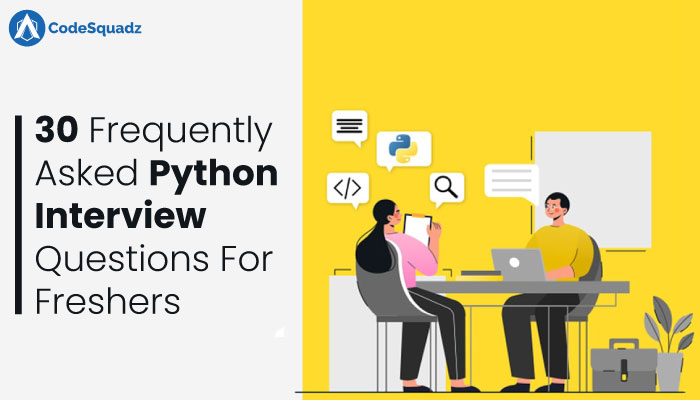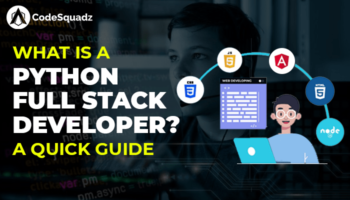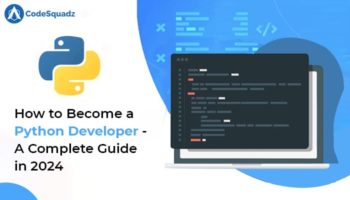Python is one of the leading and the most sought-after programming languages with a community of more than 15.5M programmers. This language was designed by Guido Van Rossum in 1991 which has a special feature of being object-oriented. Its usage is continuously increasing because it enables every user to get the flexibility of incorporating dynamic semantics.
Do you know that the popularity of Python has increased tremendously over the past few years? It allows a developer to write code and create complex applications in a readable syntax. Thus, many organizations adopt it to create helpful websites and software development.
If you are a fresher preparing to appear for an interview in Python in this competitive age, then you need Python training to increase your chances of cracking it. This article will help you know the 30 most frequently asked Python interview questions in 2023.
Python interview questions for freshers
Currently, Python is one of the most in-demand skills that offers a promising career to its developers. Therefore, many are learning and mastering Python to stay ahead of the curve, especially through this helpful guide showcasing the top 30 frequently asked Python questions for freshers.
Q.1 What is Python?
Python is a high-level, general-purpose, and object-oriented programming language. It has a design that makes it highly readable and compatible with different devices. Moreover, Python supports exception handling, threads, and memory management (automatic) to build a useful application.
Python is easy to read because it has a simple syntax similar to the English language. It has different versions and the most recent one is Python 3 (Python 2 is also a popular version).
Q.2 What are the key features of Python?
Undoubtedly, Python is popular among programmers and many use it to develop highly-useful applications (or websites). It has some of the leading features that are given below.
- Python is easy to read compared to other advanced programming languages.
- Python has a simple syntax that is similar to the English language which makes it simple to learn.
- Python can easily work on an interpreter system implying that a code can run in real-time.
- Python doesn’t use semicolons to complete a command, instead, it uses new lines.
- Python has a simple syntax enabling a programmer to complete writing a code using a simple language.
- Python is popular for handling big data and performing complex mathematics easily.
- Python programming language is interpreted eliminating the need to compile it first to run it.
- Python is a portable programming language, meaning that it can run on any machine.
Q.3 What is PEP 8?
Python Enhancement Program (PEP) is an official document designed to provide clarity to the Python community about Python’s new features and its process. It has a list of guidelines about how to write correct Python code. It focuses on improving the quality and readability of Python code.
Q.4 How is memory managed in Python?
Python can easily handle memory management using the Python Memory Manager This manager allocates the memory of Python as a Private Heap Space. When it comes to managing a large amount of data, memory management becomes a necessity because it helps to write efficient and maintainable code. The following are the popular techniques to manage memory in Python.
Garbage Collection: It is a process through which an interpreter frees up the space of the machine and makes it available for other objects.
Reference Counting: It is a memory approach used to manage memory in the Python programming language that automatically tracks how many times an object is referenced.
Q.5 What is a Python decorator?
A decorator in Python is an advanced & powerful tool, that enables programmers to add more functionalities to the current code written in the Python programming language. It is popular as metaprogramming because it’s a part of Python that allows a specific part of the Python program that tries to modify another part of Python code. It is famous because it enables any programmer to modify Python code without changing the existing code written in Python language.
Q.6 Explain the difference between a list and a tuple.
| List | Tuples |
| Elements can be modified after creation. | Elements cannot be modified after creation. |
| Defined using [ ] brackets. | Defined using () brackets. |
| Iterations are often time-consuming. | Iterations are comparatively time-saving. |
| Consume more memory. | Consume comparatively less memory. |
| Contains multiple built-in methods. | Contains no built-in methods due to immutability. |
Q.7 What are the different types of Python literals?
Numeric literals:
Three types of numeric literals are named, Integers, Floats, or Complex numbers. The Integers are both positive and negative numbers including zero and no fractional numbers, whereas Floats are real numbers having both integers and fractional numbers, and lastly, Complex numbers consist of a real and a complex part.
String literals:
The Python String Literals are created by writing text that contains single quotes (“), double quotes (“ ”), and triple quotes. Every quote can be displayed in a desired way, where the triple quotes multi-line string can be written.
Boolean literals:
There are only two Python Boolean literals, True and False, where true represents the value as 1 and False represents the value as 0.
Literal collections:
These include four literal collections list literals ([]), tuple literals (()), dict literals ({}), and set literals.
Q.8 What is the purpose of the _init_ method in Python classes?
The __init__ method is required whenever a developer creates an object from the class. Additionally, the method is used to let the class initialize an object’s attributes, and this is the only purpose of the __init__ method.
The method is also helpful in setting the initial state of an object by assigning values to its attributes. Hence, professionals later access these attributes.
Q.9 Explain the concept of Python generators.
Generators in Python can be defined using the def keyword, however, unlike the normal function where we use a return statement, a yield statement is used in Python generators.
Therefore, when the function of the generator is called, the function body is not executed immediately, instead, to produce the values, it returns a generator object that can be iterated.
Additionally, python generators are often leveraged for generating large sequences of values in a memory-efficient manner. However, the values are generated one at a time, enabling reduced memory consumption.
Q.10 How do you handle exceptions in Python?
The try…except block is used by the programmers to handle exceptions in the Python programming language. For example, whenever the code is placed to form an exception inside the try block, the try block is always followed by an except block. Hence, when an exception occurs the except block catches, and the except block cannot be used without the try block.
Q.11 What is the purpose of the yield keyword in Python?
The Yield keyword is often used to create the generator function, allowing any expression to convert into a generator object and eventually return it to the caller. As a result, coders iterate over the generator object for obtaining the values stored over there. , ,e
Notably, the yield keyword is memory efficient, as the execution only occurs when the caller iterates over the object. However, to make the overall process effective and make the handling process time-saving, the generator functions must be handled smoothly otherwise it might create errors in the program.
Q.12 How do you open and close a file in Python?
Python is famous because it allows all programmers to read and write its code. To open the Python file, the open () function is used and, using this function will open a programmer and return two arguments (accepting the file name and access mode).
Python usually closes any file on its own, however, a programmer can also use the close() function. Once the file is closed, any modification done on it gives a value error.
Q.13 Explain the concept of list comprehension in Python.
List comprehension in the Python programming language is a compact way of creating a list of the values of an existing list. It is a single line of code having square brackets [] and a programmer can use it to format or modify the code. It provides a compact syntax compared to traditional loops and syntax. A programmer can easily modify the code by reducing the requirement for an explicit number of loops and conditional sentences.
Q.14 What is the purpose of the pass statement in Python?
Pass statement (also known as null statement) in Python which is useful to create an empty class or function. The purpose of a pass statement in Python is to create the structure of a block, function, or conditional statement without any implementation details.
Q.15 What are the built-in data types in Python?
Python has many built-in data types useful to easily represent different types of data. A few of the leading built-in data types are given below.
Numeric Data Type
- int (represents integers).
- float (represents floating-point numbers with decimal places).
- complex (represents complex numbers with real & imaginary parts).
String Data Type
- str (represents strings of characters)
Sequence Types
- list (represents ordered and mutable elements in square brackets)
- tuple (represents ordered and immutable elements in square brackets)
- range (represents ordered and immutable elements in parentheses)
Binary Types
- bytes (represents 8 bits in 0 and 1)
- byterrary (represents the mutable sequence of integers)
- memoryview (allow code to access the internal data of the object)
Mapping Data Types
- dict (represents key-value pairs)
Boolean Type
- bool (represents boolean values True or False)
Q.16 What is the difference between append() and extend() methods of a list?
| append() | extend() |
| This method adds a single element at the end of a code | This method adds multiple elements at the end of a code |
| The length of the code only increases by one | Length increases by the number of elements added |
| The constant time complexity of o(1). | Time complexity is equal to o(n). |
Q.17 How do you perform file I/O operations in Python?
Python has I/O functions that are built-in like input() and print(). Here, the input() function reads user input into the memory and is defined as standard input (sys.stdin).
The print() function presents the output of a program and is defined as standard output (sys.stdout).
Q.18 What is the purpose of the super() function in Python?
In the Python programming language, the super() function to access methods and properties of a parent class. Programmers commonly use it to avoid redundant code by making it more organized so that it can be easily maintained.
Q.19 Explain the concept of lambda functions in Python.
Lambda functions in Python are similar to user-defined functions but without having any name. In Python, they are commonly known as Anonymous functions and are denoted by the lambda() keyword.
This Anonymous function doesn’t return any return keyword and It will return the outcome of the code on its own. A programmer can use the lambda function to create a simple and easy-to-read expression.
Q. 20 What is docstring in Python?
Docstring in Python is a convenient way for a programmer to associate documents with Python modules, functions, and classes. It describes what is the role of a function.
Docstring in Python can be declared by a programmer using triple-double quotes and begin with a capital letter & end with a period.
Q. 21 What are Python modules?
Python modules are files having code that defines the classes, functions, and variables (reusable in other Python programs). In other words, it is a file with a set of functions to include in an application. Python can also be considered a code library.
Q. 22 Explain the difference between Shallow copy and Deep copy in Python.
| Shallow Copy | Deep Copy |
|---|---|
| Stores the object reference to the Python’s original memory address | Stores the object value’s copies |
| Any changes made to the nested objects will be reflected in both copy and original object | Any changes will not affect in the deep copy will not affect the original object |
| Stores the copy of the original object | Stores the copy of the original object and recursively copies objects |
| Performed using the copy() method | Performed using the deepcopy() method |
Q. 23 How do you reverse a string in Python?
Python string doesn’t support the in-built “reverse()” function. However, a programmer can reverse the string easily using various ways through the following methods.
- Through for loop & appending characters (reverse order).
- Through while loop to iterate string characters
- Through the slice operator to create a reverse copy
- Through the recursion and the reversed() function
Q. 24 What is the purpose of the global keyword in Python?
A global keyword permits a programmer to modify a variable outside of the current scope and in a local context. It is used inside a function when a programmer wants to change a variable.
Q. 25 Explain the concept of inheritance in Python
Inheritance is a crucial aspect of the Python programming language that helps in Python code reusability. It permits a programmer to use a current class for creating a new class without any need to start it from scratch.
Inheritance helps to establish a hierarchical relationship among the classes (when a child class inherits properties of the parent class). It makes a program look more concise, increasing its readability.
Q. 26 What is the use of the map() function in Python?
The map() function in Python is a built-in function that returns a map object (iterator). It enables any programmer to perform a mapping operation on the sequence elements. Its key advantage is that it permits a programmer to apply the same operations to multiple elements without any need to write explicit loops.
Q. 27 What is the use of self in Python?
Self in Python represents the instances of a class and is useful to access attributes and methods in a class. A programmer uses self in Python because it doesn’t use @ syntax to refer to instance attributes. Self can also be used to access a variable field within a class.
Note: Self is not a keyword in the Python programming language.
Q. 28 How do you remove duplicates from a list in Python?
Removing duplicates from the list in Python can be completed easily using the following common methods.
- Using the “set()” function which is used to convert a list into a set and eliminate duplicate elements due to its property of storing unique values.
- Using list comprehension which is used to iterate over the elements of the original list (my_list).
- Using a for loop is easy in which a programmer requires to form a new list and iterate over the elements in the list containing duplicates and append.
Q. 29 What is the purpose of the del statement in Python?
The del statement in Python is helpful to delete variables and objects from the Python program. Here, a programmer can use the “del” keyword. These are user-defined objects, lists, sets, dictionaries, etc. It can easily be deleted from existence & memory locations in Python.
Q. 30 Explain the concept of the Global Interpreter Lock (GIL) in Python
Python Global Interpreter lock (GIL) is a process-type lock used by Python in dealing with processes. It is an important part of the multi-threading program and is used when working with multiple processes.
Python has a reference counting feature that is useful in memory management. This reference counter variable requires to be protected because sometimes two or more threads can increase or decrease its value.
Conclusion
Now, you have a list of the commonly asked Python interview questions for freshers. These questions will help freshers crack the Python-based interviews. The demand for good Python developers is ever-growing and it has some great perks. So you just need to focus on learning and increasing your knowledge base to clear any Python interview for freshers.







